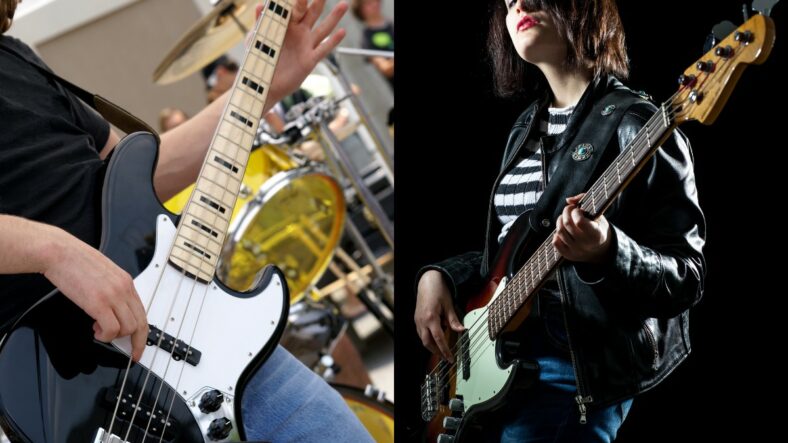7 Secrets To A Great Bass Tone

When it comes to bass guitar, having a great tone is essential for delivering a powerful performance. But what exactly makes a great bass tone? In this article, we’ll explore seven secrets to achieving a killer bass tone that will make your audience move and groove.
Contents
- The Most Important Tips for a Great Bass Tone
- 1. Understanding what influences the tone of your bass
- 2. Choosing the right bass guitar
- 3. Properly setting up your bass guitar
- 4. Selecting the right strings
- 5. Utilizing the right amplification and effects
- 6. Proper EQ and mixing techniques
- 7. Mastering your playing technique
- Conclusion
The Most Important Tips for a Great Bass Tone
- Choose the right bass guitar based on factors such as body type, body and neck materials, tonewood, pickups, number of strings, and scale length.
- Properly set up your bass guitar by adjusting string action, intonation, truss rod adjustment, and pickup height.
- Use the correct strings for the sound you want.
- Use a good proper amp and effects.
- Understand the frequency spectrum of a bass guitar for effective EQ settings.
- Master your technique and play style.
1. Understanding what influences the tone of your bass
The tone of the bass guitar is influenced by a variety of factors, including the type of bass guitar, the strings, the amplifier, and the player’s technique which we will cover even more in-depth later in the article. To achieve a great bass tone, it is important to strike a balance between clarity, punch, and definition without dominating the rest of the instruments in the mix.
2. Choosing the right bass guitar
There are several factors to consider when selecting a bass guitar, including body type, body and neck materials, tonewood, pickups, number of strings, and scale length.
Different body types and their tone
There are 4 main body types for the bass guitar namely: Solid body, Acoustic, Semi-Hollow, and Hollowbody.
Solid Body – is the most common type of bass guitar. It has a solid body made from a single piece of wood, and it is designed to produce a bright and punchy sound.
Acoustic – is a type of bass guitar that is designed to be played without the use of an amplifier. It produces sound through its hollow body and soundhole, much like an acoustic guitar.
Semi-Hollow – has a body that is partially hollowed out, with a solid center block. This design provides a warmer and more mellow tone than a solid body bass guitar.
Hollowbody – has a fully hollowed-out body, which gives it a rich and resonant tone. However, this type of bass guitar is more prone to feedback.
Body and Fingerboard Tonewoods
Bass guitars utilize different kinds of tonewood, with rosewood or maple commonly used for the fingerboard. Nevertheless, other materials like ebony, pau ferro, or walnut may also be used. Rosewood, being a softer wood, typically produces a softer tone compared to the brighter and more snappy tone produced by the harder maple.
Conversely, when it comes to the body, ashwood, mahogany, alder, and basswood are among the popular choices, but there are several other types of wood available for use, including poplar, spruce, and koa. Similar to the fingerboard, the tonal characteristics of the wood utilized in the body differ, with ashwood typically producing a brighter tone due to its hardness, while the softness of alder results in warm tones. The selection of tonewood is an important factor in determining the overall sound quality, resonance, and sustain of the bass guitar.
Pickups
There are 5 main pickups to consider when choosing a bass namely: Single-coil, Split-coil, Humbucker, Soapbar, and Active pickups.
Single-coil pickups – These pickups have a single coil of wire wrapped around a magnet and produce a bright, clear sound. An example of a bass with single coil pickups would be the Fender Jazz Bass.
Split-coil pickups – These pickups have two coils placed side by side, with each coil covering two adjacent strings. They cancel out hum and noise and produce a fuller, deeper sound. An example would be the Fender Precision Bass.
Humbucker pickups – These pickups have two coils wired together in series, and they cancel out hum and noise. They produce a warm, thick sound. An example of a bass with humbuckers would be the Sterling By Music Man SUB Series Ray4HH Bass.
Soapbar pickups – These pickups are named after their rectangular shape and produce a clear, punchy sound. An example would be the Ibanez SR500E Electric Bass.
Active pickups – These pickups require a battery to power them, and they produce a high-output, modern sound. They often have controls to boost or cut certain frequencies and are commonly found on basses used for metal, rock, and other heavy styles of music. An example would be the Schecter Riot-5 Bass.
3. Properly setting up your bass guitar
Even the best bass guitar won’t sound great if it’s not properly set up. A well-setup bass guitar is essential to achieving optimal tone. Key components of a proper setup include string action, intonation, truss rod adjustment, and pickup height.
Action
Action basically means the distance of your string from your fretboard. Low action is generally what you want so that you can play fast, comfortably, and have that snappy tone. To adjust the action, you might need to adjust your truss rod and/or adjust your bridge saddles.
Check out “How to Setup a Bass” by Marcelo Feldman below for a more detailed look at how to adjust your action.
Intonation
Intonation is basically making sure that your bass guitar is in tune wherever part of the fretboard you play. To intonate your bass you need a metronome to check if you are in tune while the string is open and while it is fretted at the 12th fret. If you are not in tune at the 12th fret you can simply adjust by lengthening or shortening the distance of the bridge to the nut by adjusting the bridge saddles forward or backward.
For a more detailed tutorial on how to adjust your intonation check out “How To Fix Bass Guitar Intonation” by The Bass Bench below.
Pickup height
Pickup height is the distance of the strings from the pickup. Some people want it closer to have a louder tone, while others prefer a softer tone by having it a bit back. To adjust the height, all you need to do is loosen or tighten the screws next to the pickup.
For a more detailed look at how to adjust pickup height, check out “How to Adjust Pickup Height on a Bass” by Howcast below to learn more.
If you’re not comfortable doing a setup yourself, it’s always a good idea to seek professional help.
4. Selecting the right strings
Different types of bass strings can have a big impact on tone. Roundwound, flatwound, and tapewound strings all have their own unique characteristics. Factors to consider when choosing strings include material, gauge, and coating. Experimenting with different strings can help you find your ideal tone. We’ve gone into detail about different types of string wounds and compared the pros and cons of each so consider giving that article a read!
5. Utilizing the right amplification and effects
Choosing the right bass amp and effects can also have a big impact on your tone. Combo amps and separate head and cabinet setups both have their own advantages. Tube amps can produce a warm, vintage tone, while solid-state amps are more reliable and affordable. We’ve covered a lot of topics about amps before and if you want to learn more check out our article on the best gigging amps.
Utilizing the right effect pedals are the way to go if you want to achieve some fantastic bass tones! Popular bass effects include compression, overdrive and distortion, chorus, and octave. But if you want an all-in-one package then consider using a multi-effects pedal instead. We’ve covered the best bass multi-effects pedals before so consider checking it out.
6. Proper EQ and mixing techniques
Understanding the frequency spectrum of a bass guitar is important for effective EQ settings. Cutting low-mids can help improve clarity while boosting high-mids can add presence. It’s also important to balance bass volume with other instruments and avoid frequency clashes. If you’re looking for gear to adjust your EQ, we did an article before on the best guitar and bass EQ pedals, check it out to learn more!
While developing mixing techniques and mastering how to properly EQ can be challenging, you can start by researching and watching tutorials, or ultimately seek guidance from a professional.
7. Mastering your playing technique
Finally, your playing technique can also have a big impact on your bass tone. Different playing techniques, such as fingerstyle, picking, slapping, and popping, can all produce different tones. If you haven’t started developing your playing technique yet, check out our article comparing different playing techniques in order to learn more about what you should master first.
A consistent technique is important for achieving a great bass tone, and developing your own unique playing style can help you stand out.
Conclusion
By following these seven secrets, you’ll be well on your way to achieving a great bass tone that enhances your music and showcases your unique playing style! And don’t forget to have some fun with it – trying new things and exploring different sounds is all part of the journey to finding your perfect bass tone, and it’s totally worth it in the end. So go ahead, let your creativity run wild, and see where it takes you!





